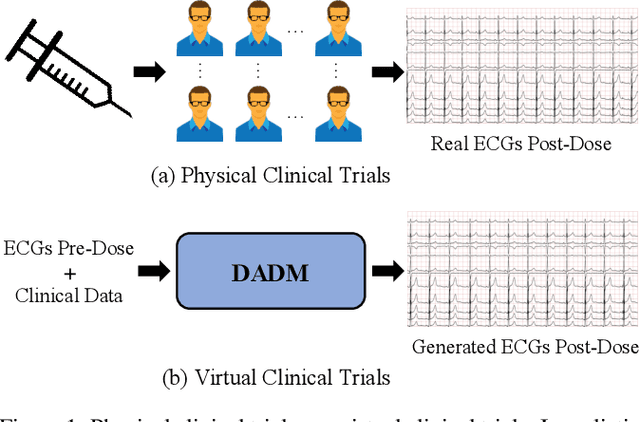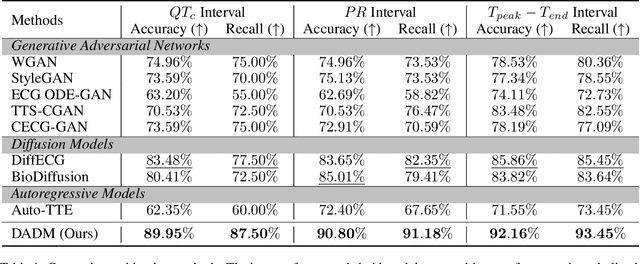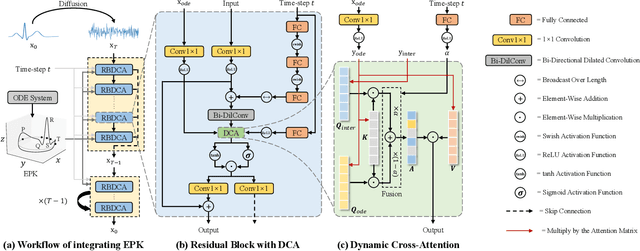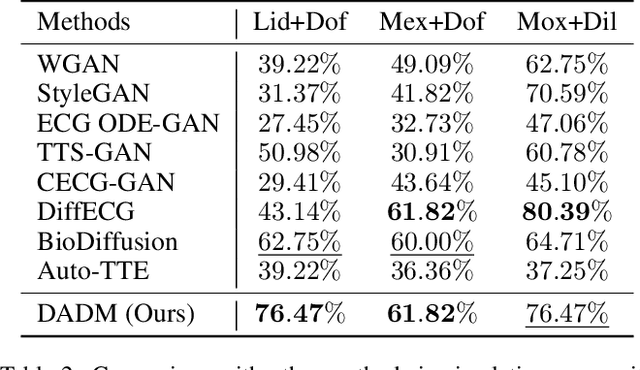Jintai Chen
Utilizing Training Data to Improve LLM Reasoning for Tabular Understanding
Aug 26, 2025Abstract:Automated tabular understanding and reasoning are essential tasks for data scientists. Recently, Large language models (LLMs) have become increasingly prevalent in tabular reasoning tasks. Previous work focuses on (1) finetuning LLMs using labeled data or (2) Training-free prompting LLM agents using chain-of-thought (CoT). Finetuning offers dataset-specific learning at the cost of generalizability. Training-free prompting is highly generalizable but does not take full advantage of training data. In this paper, we propose a novel prompting-based reasoning approach, Learn then Retrieve: LRTab, which integrates the benefits of both by retrieving relevant information learned from training data. We first use prompting to obtain CoT responses over the training data. For incorrect CoTs, we prompt the LLM to predict Prompt Conditions to avoid the error, learning insights from the data. We validate the effectiveness of Prompt Conditions using validation data. Finally, at inference time, we retrieve the most relevant Prompt Conditions for additional context for table understanding. We provide comprehensive experiments on WikiTQ and Tabfact, showing that LRTab is interpretable, cost-efficient, and can outperform previous baselines in tabular reasoning.
Mitigating Hallucination of Large Vision-Language Models via Dynamic Logits Calibration
Jun 26, 2025Abstract:Large Vision-Language Models (LVLMs) have demonstrated significant advancements in multimodal understanding, yet they are frequently hampered by hallucination-the generation of text that contradicts visual input. Existing training-free decoding strategies exhibit critical limitations, including the use of static constraints that do not adapt to semantic drift during generation, inefficiency stemming from the need for multiple forward passes, and degradation of detail due to overly rigid intervention rules. To overcome these challenges, this paper introduces Dynamic Logits Calibration (DLC), a novel training-free decoding framework designed to dynamically align text generation with visual evidence at inference time. At the decoding phase, DLC step-wise employs CLIP to assess the semantic alignment between the input image and the generated text sequence. Then, the Relative Visual Advantage (RVA) of candidate tokens is evaluated against a dynamically updated contextual baseline, adaptively adjusting output logits to favor tokens that are visually grounded. Furthermore, an adaptive weighting mechanism, informed by a real-time context alignment score, carefully balances the visual guidance while ensuring the overall quality of the textual output. Extensive experiments conducted across diverse benchmarks and various LVLM architectures (such as LLaVA, InstructBLIP, and MiniGPT-4) demonstrate that DLC significantly reduces hallucinations, outperforming current methods while maintaining high inference efficiency by avoiding multiple forward passes. Overall, we present an effective and efficient decoding-time solution to mitigate hallucinations, thereby enhancing the reliability of LVLMs for more practices. Code will be released on Github.
Comorbidity-Informed Transfer Learning for Neuro-developmental Disorder Diagnosis
Apr 13, 2025



Abstract:Neuro-developmental disorders are manifested as dysfunctions in cognition, communication, behaviour and adaptability, and deep learning-based computer-aided diagnosis (CAD) can alleviate the increasingly strained healthcare resources on neuroimaging. However, neuroimaging such as fMRI contains complex spatio-temporal features, which makes the corresponding representations susceptible to a variety of distractions, thus leading to less effective in CAD. For the first time, we present a Comorbidity-Informed Transfer Learning(CITL) framework for diagnosing neuro-developmental disorders using fMRI. In CITL, a new reinforced representation generation network is proposed, which first combines transfer learning with pseudo-labelling to remove interfering patterns from the temporal domain of fMRI and generates new representations using encoder-decoder architecture. The new representations are then trained in an architecturally simple classification network to obtain CAD model. In particular, the framework fully considers the comorbidity mechanisms of neuro-developmental disorders and effectively integrates them with semi-supervised learning and transfer learning, providing new perspectives on interdisciplinary. Experimental results demonstrate that CITL achieves competitive accuracies of 76.32% and 73.15% for detecting autism spectrum disorder and attention deficit hyperactivity disorder, respectively, which outperforms existing related transfer learning work for 7.2% and 0.5% respectively.
OrderChain: A General Prompting Paradigm to Improve Ordinal Understanding Ability of MLLM
Apr 07, 2025Abstract:Despite the remarkable progress of multimodal large language models (MLLMs), they continue to face challenges in achieving competitive performance on ordinal regression (OR; a.k.a. ordinal classification). To address this issue, this paper presents OrderChain, a novel and general prompting paradigm that improves the ordinal understanding ability of MLLMs by specificity and commonality modeling. Specifically, our OrderChain consists of a set of task-aware prompts to facilitate the specificity modeling of diverse OR tasks and a new range optimization Chain-of-Thought (RO-CoT), which learns a commonality way of thinking about OR tasks by uniformly decomposing them into multiple small-range optimization subtasks. Further, we propose a category recursive division (CRD) method to generate instruction candidate category prompts to support RO-CoT automatic optimization. Comprehensive experiments show that a Large Language and Vision Assistant (LLaVA) model with our OrderChain improves baseline LLaVA significantly on diverse OR datasets, e.g., from 47.5% to 93.2% accuracy on the Adience dataset for age estimation, and from 30.0% to 85.7% accuracy on the Diabetic Retinopathy dataset. Notably, LLaVA with our OrderChain also remarkably outperforms state-of-the-art methods by 27% on accuracy and 0.24 on MAE on the Adience dataset. To our best knowledge, our OrderChain is the first work that augments MLLMs for OR tasks, and the effectiveness is witnessed across a spectrum of OR datasets.
Biomedical Foundation Model: A Survey
Mar 03, 2025Abstract:Foundation models, first introduced in 2021, are large-scale pre-trained models (e.g., large language models (LLMs) and vision-language models (VLMs)) that learn from extensive unlabeled datasets through unsupervised methods, enabling them to excel in diverse downstream tasks. These models, like GPT, can be adapted to various applications such as question answering and visual understanding, outperforming task-specific AI models and earning their name due to broad applicability across fields. The development of biomedical foundation models marks a significant milestone in leveraging artificial intelligence (AI) to understand complex biological phenomena and advance medical research and practice. This survey explores the potential of foundation models across diverse domains within biomedical fields, including computational biology, drug discovery and development, clinical informatics, medical imaging, and public health. The purpose of this survey is to inspire ongoing research in the application of foundation models to health science.
A Survey on Ordinal Regression: Applications, Advances and Prospects
Mar 02, 2025Abstract:Ordinal regression refers to classifying object instances into ordinal categories. Ordinal regression is crucial for applications in various areas like facial age estimation, image aesthetics assessment, and even cancer staging, due to its capability to utilize ordered information effectively. More importantly, it also enhances model interpretation by considering category order, aiding the understanding of data trends and causal relationships. Despite significant recent progress, challenges remain, and further investigation of ordinal regression techniques and applications is essential to guide future research. In this survey, we present a comprehensive examination of advances and applications of ordinal regression. By introducing a systematic taxonomy, we meticulously classify the pertinent techniques and applications into three well-defined categories based on different strategies and objectives: Continuous Space Discretization, Distribution Ordering Learning, and Ambiguous Instance Delving. This categorization enables a structured exploration of diverse insights in ordinal regression problems, providing a framework for a more comprehensive understanding and evaluation of this field and its related applications. To our best knowledge, this is the first systematic survey of ordinal regression, which lays a foundation for future research in this fundamental and generic domain.
Generation of Drug-Induced Cardiac Reactions towards Virtual Clinical Trials
Feb 11, 2025



Abstract:Clinical trials are pivotal in cardiac drug development, yet they often fail due to inadequate efficacy and unexpected safety issues, leading to significant financial losses. Using in-silico trials to replace a part of physical clinical trials, e.g., leveraging advanced generative models to generate drug-influenced electrocardiograms (ECGs), seems an effective method to reduce financial risk and potential harm to trial participants. While existing generative models have demonstrated progress in ECG generation, they fall short in modeling drug reactions due to limited fidelity and inability to capture individualized drug response patterns. In this paper, we propose a Drug-Aware Diffusion Model (DADM), which could simulate individualized drug reactions while ensuring fidelity. To ensure fidelity, we construct a set of ordinary differential equations to provide external physical knowledge (EPK) of the realistic ECG morphology. The EPK is used to adaptively constrain the morphology of the generated ECGs through a dynamic cross-attention (DCA) mechanism. Furthermore, we propose an extension of ControlNet to incorporate demographic and drug data, simulating individual drug reactions. We compare DADM with the other eight state-of-the-art ECG generative models on two real-world databases covering 8 types of drug regimens. The results demonstrate that DADM can more accurately simulate drug-induced changes in ECGs, improving the accuracy by at least 5.79% and recall by 8%.
A Survey of Embodied AI in Healthcare: Techniques, Applications, and Opportunities
Jan 13, 2025



Abstract:Healthcare systems worldwide face persistent challenges in efficiency, accessibility, and personalization. Powered by modern AI technologies such as multimodal large language models and world models, Embodied AI (EmAI) represents a transformative frontier, offering enhanced autonomy and the ability to interact with the physical world to address these challenges. As an interdisciplinary and rapidly evolving research domain, "EmAI in healthcare" spans diverse fields such as algorithms, robotics, and biomedicine. This complexity underscores the importance of timely reviews and analyses to track advancements, address challenges, and foster cross-disciplinary collaboration. In this paper, we provide a comprehensive overview of the "brain" of EmAI for healthcare, wherein we introduce foundational AI algorithms for perception, actuation, planning, and memory, and focus on presenting the healthcare applications spanning clinical interventions, daily care & companionship, infrastructure support, and biomedical research. Despite its promise, the development of EmAI for healthcare is hindered by critical challenges such as safety concerns, gaps between simulation platforms and real-world applications, the absence of standardized benchmarks, and uneven progress across interdisciplinary domains. We discuss the technical barriers and explore ethical considerations, offering a forward-looking perspective on the future of EmAI in healthcare. A hierarchical framework of intelligent levels for EmAI systems is also introduced to guide further development. By providing systematic insights, this work aims to inspire innovation and practical applications, paving the way for a new era of intelligent, patient-centered healthcare.
ProtCLIP: Function-Informed Protein Multi-Modal Learning
Dec 28, 2024Abstract:Multi-modality pre-training paradigm that aligns protein sequences and biological descriptions has learned general protein representations and achieved promising performance in various downstream applications. However, these works were still unable to replicate the extraordinary success of language-supervised visual foundation models due to the ineffective usage of aligned protein-text paired data and the lack of an effective function-informed pre-training paradigm. To address these issues, this paper curates a large-scale protein-text paired dataset called ProtAnno with a property-driven sampling strategy, and introduces a novel function-informed protein pre-training paradigm. Specifically, the sampling strategy determines selecting probability based on the sample confidence and property coverage, balancing the data quality and data quantity in face of large-scale noisy data. Furthermore, motivated by significance of the protein specific functional mechanism, the proposed paradigm explicitly model protein static and dynamic functional segments by two segment-wise pre-training objectives, injecting fine-grained information in a function-informed manner. Leveraging all these innovations, we develop ProtCLIP, a multi-modality foundation model that comprehensively represents function-aware protein embeddings. On 22 different protein benchmarks within 5 types, including protein functionality classification, mutation effect prediction, cross-modal transformation, semantic similarity inference and protein-protein interaction prediction, our ProtCLIP consistently achieves SOTA performance, with remarkable improvements of 75% on average in five cross-modal transformation benchmarks, 59.9% in GO-CC and 39.7% in GO-BP protein function prediction. The experimental results verify the extraordinary potential of ProtCLIP serving as the protein multi-modality foundation model.
Take Your Steps: Hierarchically Efficient Pulmonary Disease Screening via CT Volume Compression
Dec 03, 2024Abstract:Deep learning models are widely used to process Computed Tomography (CT) data in the automated screening of pulmonary diseases, significantly reducing the workload of physicians. However, the three-dimensional nature of CT volumes involves an excessive number of voxels, which significantly increases the complexity of model processing. Previous screening approaches often overlook this issue, which undoubtedly reduces screening efficiency. Towards efficient and effective screening, we design a hierarchical approach to reduce the computational cost of pulmonary disease screening. The new approach re-organizes the screening workflows into three steps. First, we propose a Computed Tomography Volume Compression (CTVC) method to select a small slice subset that comprehensively represents the whole CT volume. Second, the selected CT slices are used to detect pulmonary diseases coarsely via a lightweight classification model. Third, an uncertainty measurement strategy is applied to identify samples with low diagnostic confidence, which are re-detected by radiologists. Experiments on two public pulmonary disease datasets demonstrate that our approach achieves comparable accuracy and recall while reducing the time by 50%-70% compared with the counterparts using full CT volumes. Besides, we also found that our approach outperforms previous cutting-edge CTVC methods in retaining important indications after compression.
 Add to Chrome
Add to Chrome Add to Firefox
Add to Firefox Add to Edge
Add to Edge